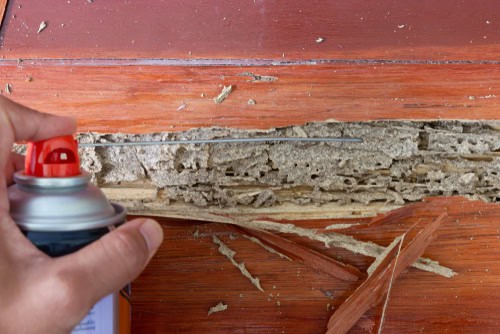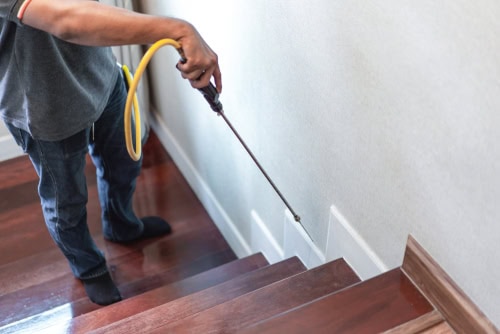
How Do Termites Destroy Home?
September 27, 2021
Can Termites Get Into Your Bed?
January 12, 2022Health Dangers Of Termites In Your Home

Health Dangers Of Termites In Your Home – The warm, moist conditions of the home are perfect for termites to live and breed. What’s alarming is that there can be more than one family of termites living in your house at any given time. That means you may have different types of termites in your walls or under the floorboards.
If not dealt with promptly, this could lead to a full-on infestation. Read on – Health Dangers Of Termites In Your Home
Termites Digest Wood And Eat Through Concrete Too!

These little bugs are known as detrivores, which means “to eat dead things.” The termite gut can’t break down cellulose on its own, but the microbes that live in their digestive system have enzymes that do just that.
What Are Termites?

Termites are commonly known as wood-eating insects that live primarily outdoors feeding on plant cellulose such as between boards and under tar paper; however, while this is true, some species prefer decaying matter or materials high in nitrogen like straw or manure.
The most common termites are subterranean termites that live underground and swell in population while consuming wood from a structure they have invaded via small cracks, crevices, or utility holes.
Unlike most other insects, termites require moisture to survive and will swarm around leaks in roofs, showers, and sinks when humidity levels rise around these areas.
Termite Colonies And Swarmers

Each colony of termites is composed of several types of individuals including:
- Queens
- Workers, which can be further broken down into smaller groups called:
- subterranean
- dirt, and:
- wood.
The main difference between these castes is size and function; for instance, only the queen can reproduce. Worker termites are responsible for expanding their colony’s territory by building tunnels and feeding the other members of the colony.
As workers scavenge for food, they gather soil particles that help maintain the moisture content in their underground nest; however, this function becomes extremely dangerous if it brings these castes into contact with another nearby colony or humans working on structures close by.
Termite And Your Health

Although many people believe that termites pose no real danger to human health, there are some risks associated with these insects that you should be aware of:
Allergic Reactions
As stated above, termites present serious allergies that can cause respiratory problems.
Cancer
While not proven, termites are made up of cellulose which is known to cause serious cancers in mice including brain cancer when they come in contact with this material.
Diseases
Termites can carry several diseases that are harmful to humans including typhoid fever, cholera, and dysentery.
Termite Detection And Prevention Methods

Identification of termite infestations cannot be accomplished by the naked eye; however, you can use the following methods for detection:
Take note of any type of wood damage or paper-thin pieces found around your home’s foundation areas.
These colonies thrive on moist paper products so look closely near holes or cracks where moisture may seep in. A good way to test for their presence is by placing small portions of moist bread or candy near suspected areas and monitoring for any forms of wood damage overnight. For those with a pest control service, try contacting them to inspect your home for infestations.
Regardless of the method you choose to detect a termite infestation, it’s always a good idea to contact a professional who specializes in issues
After detection has been made by anyone, prevention is where you should focus because even if these colonies are driven out from one area, they will always return since they produce large numbers of offspring each year.
Termites Control methods

Termite Barrier System
This system is composed of several components that include concrete footings poured at least 3ft deep, a chemical solution that acts as a barrier, and numerous metal plates that are driven into the ground around your home’s foundation. These systems have been known to keep termites away from structures for 15-25 years depending on the quality of their construction.
Pest Control Service
It’s best to contact a pest control service at least once each year for inspections because they will be able to identify any type of damage or changes in your foundation from past issues due to termites. If any evidence is found, schedule quarterly visits with them using liquid chemicals as protection.
This method works great if you do it regularly so try investing in an annual contract with these companies.
Pesticide Treatment
This may come as somewhat of a surprise but pesticides are not always the best option for termites; in fact, there are so many flaws to this method that it’s almost not worth doing. One major concern is the lack of thoroughness when applying pesticides to your home’s foundation which means colonies may be hiding deep within the soil and avoid being exterminated.
Another risk associated with pesticide treatments comes from its ingredients which can contaminate humans or pets if used incorrectly so be sure you understand these chemicals before using them yourself.
They usually stay underground all day long, only coming up to get food when it’s dark outside (the sunlight will kill them). These little tunnels that they create are how they’ll get into your house — by digging right through the foundation! So if you think you’re safe inside because there are no visible signs of termites on the surface, think again!
Health Dangers Of Termites In Your Home – Conclusion

To summarize, termites pose several risks including allergic reactions, serious cancers and diseases carried by these insects so have a pest control service inspect your home every year and request liquid chemical treatment as a last resort. Don’t forget that termites thrive on wood materials so perform regular inspections for any type of damage around your home’s foundation.




